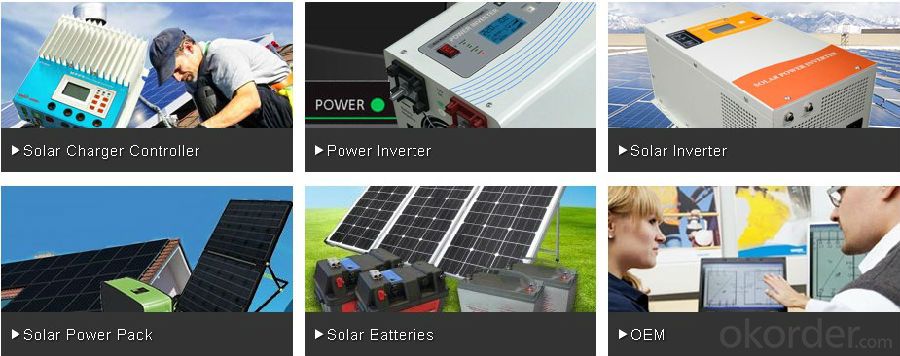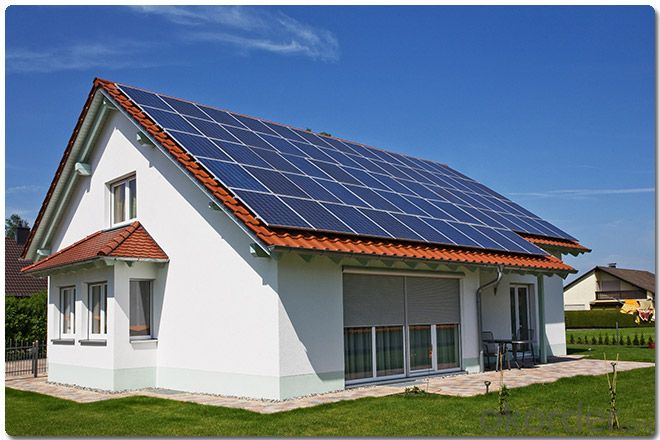1440W Solar Hybrid Inverter Excellent Quality 2000VA with Competitive Price
- Loading Port:
- China main port
- Payment Terms:
- TT OR LC
- Min Order Qty:
- 10 pc
- Supply Capability:
- 1000 pc/month
OKorder Service Pledge
OKorder Financial Service
You Might Also Like
Features:
. Pure sine wave inverter
. Selectable input voltage range for home appliances and personal computers
. Selectable charging current based on applications
. Configurable AC/Solar input priority via LCD setting
. Compatible to mains voltage or generator power
. Parallel operation with up to 4 units only available for PV200 4KVA/5KVA
. Auto restart while AC is recovering
. Overload and short circuit protection
. Smart battery charger design for optimized battery performance
. Cold start function
| Model | PV1800-1KVA | PV1800-2KVA | PV1800-3KVA | PV1800-4KVA | PV1800-5KVA |
| RATED POWER | 1000VA / 800W | 2000VA/ 1600W | 3000VA / 2400W | 4000VA / 3200W | 5000VA / 4000W |
| INPUT | |||||
| Voltage | 230 VAC | ||||
| Selectable Voltage Range | 170-280 VAC (For Personal Computers) ; 90-280 VAC (For Home Appliances) | ||||
| Frequency Range | 50 Hz/60 Hz (Auto sensing) | ||||
| OUTPUT | |||||
| AC Voltage Regulation (Batt. Mode) | 230 VAC ± 5% | ||||
| Surge Power | 2000VA | 4000VA | 6000VA | 8000VA | 10000VA |
| Efficiency (Peak) | 90% | 93% | |||
| Transfer Time | 10 ms (For Personal Computers) ; 20 ms (For Home Appliances) | ||||
| Waveform | Pure sine wave | ||||
| BATTERY | |||||
| Battery Voltage | 12 VDC | 24 VDC | 48 VDC | ||
| Floating Charge Voltage | 13.5 VDC | 27 VDC | 54 VDC | ||
| Overcharge Protection | 15 VDC | 30 VDC | 60 VDC | ||
| Maximum Charge Current | 10 A or 20 A | 20 A or 30 A | 20 A or 30 A | ||
| SOLAR CHARGER (OPTION) | |||||
| Charging Current | 50 A | ||||
| Maximum PV Array Open Circuit Voltage | 30 VDC | 60 VDC | 90 VDC | ||
| Standby power Consumption | 1 W | 2 W | 2 W | ||
| PHYSICAL | |||||
| Dimension, D x W x H (mm) | 95 x 240 x 316 | 100 x 272 x 355 | 120 x 295 x 468 | ||
| Net Weight (kgs) | 5.0 | 6.4 | 6.9 | 9.8 | 9.8 |
| OPERATING ENVIRONMENT | |||||
| Humidity | 5% to 95% Relative Humidity(Non-condensing) | ||||
| Operating Temperature | 0°C - 55°C | ||||
| Storage Temperature | -15°C - 60°C | ||||
Warranty
provides a 1~3 year limited warranty (“Warranty”) against defects in materials and workmanship for its Uninterruptible power supply, Power inverter/chargers, Solar charge controllers, Battery Products (“Product”).
The term of this Warranty begins on the Product(s) initial purchase date, or the date of receipt of the Product(s) by the end user, whichever is later. This must be indicated on the invoice, bill of sale, and/or warranty registration card submitted to MUST-Solar. This Warranty applies to the original MUST-Solar Product purchaser, and is transferable only if the Product remains installed in the original use location.



FAQ
1. How fast will my system respond to a power outage?
Our solar inverters typically transfer to battery power in less than 16 milliseconds (less than 1/50th of a second).
2. What kind of batteries do the systems include?
Our solar backup electric systems use special high-quality electric storage batteries.
3. How do I install my system?
A solar backup inverter is connected to a home electric system , we will supply detailed installation manual and videos for our customers .
- Q:Is it possible to upgrade my existing solar inverter without replacing the entire system?
- Yes, it is possible to upgrade an existing solar inverter without replacing the entire system. In many cases, solar inverters can be upgraded by simply replacing the existing inverter with a newer model that offers more advanced features or higher capacity. However, it is important to consult with a professional solar installer to determine the compatibility of the new inverter with your current system and ensure a successful upgrade.
- Q:Can a solar inverter be used in regions with high levels of electromagnetic interference?
- Yes, a solar inverter can be used in regions with high levels of electromagnetic interference. However, it is important to ensure that the inverter is designed and manufactured to meet the necessary electromagnetic compatibility (EMC) standards and has the appropriate shielding measures in place to minimize any interference or disruption caused by electromagnetic noise.
- Q:What is the role of a maximum power control feature in a solar inverter?
- The role of a maximum power control feature in a solar inverter is to optimize the energy output of the solar panels by constantly tracking the maximum power point (MPP) of the solar array. This feature adjusts the operating conditions of the inverter to ensure that it operates at the highest possible efficiency, maximizing the energy harvested from the solar panels and improving overall system performance.
- Q:What is the typical size and weight of a solar inverter?
- The typical size and weight of a solar inverter can vary depending on its power capacity. Generally, residential solar inverters range in size from around 30 x 50 x 20 cm (12 x 20 x 8 inches) to 60 x 60 x 30 cm (24 x 24 x 12 inches) and weigh between 10 kg (22 lbs) to 25 kg (55 lbs). Commercial or utility-scale inverters, on the other hand, can be much larger and heavier, weighing several hundred kilograms (or even tons) and occupying larger spaces.
- Q:How does a solar inverter affect the overall energy consumption of a property?
- A solar inverter affects the overall energy consumption of a property by converting the direct current (DC) electricity produced by solar panels into alternating current (AC) electricity that can be used to power electrical appliances and equipment in the property. It ensures that the electricity generated by the solar panels is compatible with the property's electrical system, reducing the dependence on grid-supplied electricity. By efficiently converting solar energy into usable electricity, a solar inverter helps to lower the property's energy consumption from traditional sources and can potentially result in energy cost savings.
- Q:Can a solar inverter be used with a solar-powered swimming pool heater?
- Yes, a solar inverter can be used with a solar-powered swimming pool heater. A solar inverter is responsible for converting the direct current (DC) energy produced by solar panels into alternating current (AC) energy that can be used to power appliances and devices. In the case of a solar-powered swimming pool heater, the solar panels generate DC energy from sunlight, which is then converted into AC energy by the solar inverter. This AC energy can be used to power the swimming pool heater and heat the pool water using solar energy.
- Q:What is the role of an anti-islanding feature in a solar inverter?
- The role of an anti-islanding feature in a solar inverter is to ensure the safety of utility workers and prevent damage to the electrical grid. It detects when there is a power outage or grid disturbance and immediately shuts off the solar inverter to prevent it from continuing to generate electricity. This feature is crucial as it prevents the solar system from operating independently and feeding power back into the grid, which can be dangerous for utility workers trying to repair the power outage.
- Q:What is the maximum operating temperature of a solar inverter?
- The maximum operating temperature of a solar inverter can vary depending on the specific model and brand. However, most solar inverters are designed to operate within a temperature range of -20°C to 60°C (-4°F to 140°F). It is important to check the manufacturer's specifications to determine the exact maximum operating temperature for a particular solar inverter.
- Q:What is the role of a solar inverter in preventing system failures?
- The role of a solar inverter in preventing system failures is to convert the direct current (DC) produced by solar panels into alternating current (AC) that can be used to power electrical devices. By continuously monitoring the performance of the solar system and ensuring the optimal conversion of power, the inverter helps to prevent issues such as voltage fluctuations, overloading, and short circuits. It also provides vital protection by promptly detecting and responding to any faults or abnormalities in the system, thereby minimizing the risk of system failures and maximizing the overall efficiency and reliability of the solar power generation.
- Q:Can a solar inverter be used in remote areas without access to the grid?
- Yes, a solar inverter can be used in remote areas without access to the grid. Solar inverters are designed to convert the direct current (DC) electricity generated by solar panels into alternating current (AC) electricity that can be used to power electrical appliances. In remote areas, solar panels can be installed to harness sunlight and convert it into electricity, which can then be used through the solar inverter to provide power to homes, businesses, or any other electrical devices without the need for a grid connection.
1. Manufacturer Overview |
|
|---|---|
| Location | |
| Year Established | |
| Annual Output Value | |
| Main Markets | |
| Company Certifications | |
2. Manufacturer Certificates |
|
|---|---|
| a) Certification Name | |
| Range | |
| Reference | |
| Validity Period | |
3. Manufacturer Capability |
|
|---|---|
| a)Trade Capacity | |
| Nearest Port | |
| Export Percentage | |
| No.of Employees in Trade Department | |
| Language Spoken: | |
| b)Factory Information | |
| Factory Size: | |
| No. of Production Lines | |
| Contract Manufacturing | |
| Product Price Range | |
Send your message to us
1440W Solar Hybrid Inverter Excellent Quality 2000VA with Competitive Price
- Loading Port:
- China main port
- Payment Terms:
- TT OR LC
- Min Order Qty:
- 10 pc
- Supply Capability:
- 1000 pc/month
OKorder Service Pledge
OKorder Financial Service
Similar products
New products
Hot products
Hot Searches
Related keywords

































